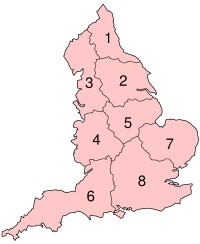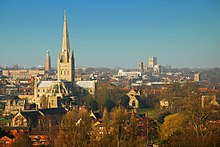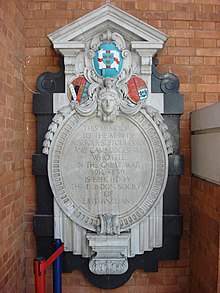East Anglia
This article needs additional citations for verification. (April 2016) |
East Anglia | |
|---|---|
| Etymology: Kingdom of the East Angles | |
 East Anglia: with the ceremonial counties of Norfolk and Suffolk (in red) to the north and south and Cambridgeshire and Essex (in pink) to the west | |
| Sovereign state | United Kingdom |
| Country | England |
| Region | East of England |
| Ceremonial counties |
|
East Anglia is an area in the East of England.[1] It comprises the counties of Norfolk and Suffolk and Cambridgeshire, with Essex also included in some definitions.[2][3] The name derives from the Anglo-Saxon kingdom of the East Angles, a people whose name originated in Anglia, in what is now Northern Germany.
Area
[edit]Definitions of what constitutes East Anglia vary. The Kingdom of East Anglia, established by Anglo-Saxons in the 6th century, originally consisted of the modern counties of Norfolk and Suffolk and expanded west into at least part of Cambridgeshire, typically the northernmost parts known as The Fens. The contemporary NUTS 2 statistical unit of East Anglia comprises Norfolk, Suffolk and Cambridgeshire (including the City of Peterborough unitary authority).[3] Those three counties have formed the Roman Catholic Diocese of East Anglia since 1976, and were the subject of a possible government devolution package in 2016.[4][5]
Essex has sometimes been included in definitions of East Anglia, including by the London Society of East Anglians.[note 1] Although the Kingdom of Essex to the south was a separate element of the Heptarchy of Anglo-Saxon England and did not identify as Angles but Saxons, many people in Essex today still consider themselves to be East Anglian. For example, Colchester United F.C. is one of the clubs competing for the informal football title Pride of Anglia, but not Southend United F.C. from further south in the county. Culturally, north Essex has much more in common with Suffolk and the rest of East Anglia due to its similar rural landscape, when compared to the south which is much more urban given its proximity to London. However, the county of Essex by itself forms a NUTS 2 statistical unit in the East of England region.


Other definitions of the area have been used or proposed over the years. For example, the Redcliffe-Maud Report in 1969, which followed the Royal Commission on the Reform of Local Government, recommended the creation of eight provinces in England. The proposed East Anglia province would have included northern Essex, southern Lincolnshire and a small part of Northamptonshire as well as Cambridgeshire, Norfolk and Suffolk.
Places described as the "gateway" to East Anglia include the Cambridgeshire towns of Ely and St Neots (traditionally in Huntingdonshire).[6]
East Anglian cities Peterborough and Cambridge have consistently been on the U.K.'s fastest growing cities in both population and economy. Compared to the rest of the U.K., East Anglia alongside the East of England has the fastest growth by population in the country.
The largest city and urban area in East Anglia is Peterborough with an urban population of 215,673 and a total population of 217,705 as of Census 2021.
History
[edit]The kingdom of East Anglia initially consisted of Norfolk and Suffolk, but the Isle of Ely also became part of it upon the marriage of East Anglian princess Æthelthryth. It was formed around 520 by merging the North and South Folk, Angles who had settled in the former lands of the Iceni during the previous century, and it was one of the Anglo-Saxon kingdoms of the heptarchy as defined in the 12th-century writings of Henry of Huntingdon.[7][page needed] East Anglia has been cited by a number of scholars as being a region where settlement of continental Germanic speakers was particularly early and dense,[8][9][10] possibly following a depopulation in the fourth century.[11]
A 2016 study found that modern East Anglians share a strong genetic affinity with early medieval skeletons, but differ substantially from Iron Age and Roman era ones, which are more similar to the Welsh. This was taken to support a major influence of the Anglian migrations on the genetic makeup of East Anglia.[12] In a 2022 study by Joscha Gretzinger et al., the populations of Norfolk and Suffolk were found to be the group with the lowest amount of Iron Age/Roman period British Isles-related ancestry, with only about 11-17.5% of their ancestry being derived from that group, while having one of the highest amounts of Continental North European (43.8-50.7%), and the highest amount of Continental West European (32.2-43.1%) ancestry in all of England.[13]
East Anglia was the most powerful of the Anglo-Saxon kingdoms of England for a brief period following a victory over the rival kingdom of Northumbria around 616, and its King Rædwald was Bretwalda (overlord of the Anglo-Saxon kingdoms). However, this did not last; the Mercians defeated it twice over the next 40 years, and East Anglia continued to weaken in relation to the other kingdoms. Offa of Mercia finally had king Æthelberht killed in 794 and took control of the kingdom himself.[14] Independence was temporarily restored by rebellion in 825, but the Danes killed King Edmund on 20 November 869 and captured the kingdom. Edward the Elder incorporated East Anglia into the Kingdom of England, and it later became an earldom.
Parts of East Anglia remained marshland until the 17th century drainage of the Fens, despite some earlier engineering work during the Roman occupation. The alluvial land was converted into wide swaths of productive arable land by a series of systematic drainage projects, mainly using drains and river diversions along the lines of Dutch practice.[citation needed] In the 1630s, thousands of Puritan families from East Anglia emigrated to New England in America, taking much East Anglian culture with them that can still be traced today.[15][page needed] East Anglia based much of its earnings on wool, textiles, and arable farming and was a rich area of England until the Industrial Revolution caused a manufacturing and development shift to the Midlands and the North.
During the Second World War, the Royal Air Force and the United States Army Air Force constructed many airbases in East Anglia for the heavy bomber fleets of the Combined Bomber Offensive against German-occupied Europe. East Anglia was ideally suited to airfield construction, as it includes large areas of open, level terrain and is close to mainland Europe. Many of the airfields can still be seen today, particularly from aerial photographs, and a few remain in use, the most prominent being Norwich International Airport. Pillboxes were erected in 1940 to help defend the nation against invasion, and they can also be found throughout the area at strategic points.[16] Similarly, but from the Napoleonic Wars, a number of Martello towers can be found along the coast.
Geography
[edit]


East Anglia is bordered to the north and east by the North Sea, to the south by the estuaries of the rivers Orwell and Stour, and shares an undefined land border to the west with the rest of England. Much of northern East Anglia is flat, low-lying and marshy (such as the Fens of Cambridgeshire and Norfolk), although the extensive drainage projects of the past centuries and very low rainfall actually make East Anglia the driest area of England.[17] Inland, much of the rest of Suffolk and Norfolk is gently undulating, with glacial moraine ridges providing some areas of steeper relief. The highest point in Norfolk is the 103 metres (338 ft) Beacon Hill;[18] the supposed flatness of Norfolk is noted in literature, including Noël Coward's Private Lives – "Very flat, Norfolk".[19]: 23
On the north-west corner East Anglia is bordered by a bay known as The Wash, where owing to deposits of sediment and land reclamation, the coastline has altered markedly within historical times; several towns once on the coast of the Wash (notably King's Lynn) are now some distance inland. Conversely, over to the east on the coast exposed to the North Sea the coastline is subject to rapid erosion and has shifted inland significantly since historic times.[citation needed]
Major rivers include the River Nene and Suffolk's Stour, running through country beloved of the painter John Constable. The River Cam is a tributary of the Great Ouse and gives its name to Cambridge, whilst Norwich sits on the River Yare and River Wensum. The River Orwell flows through Ipswich and has its mouth, along with the Stour at Felixstowe. The Norfolk and Suffolk Broads form a network of waterways between Norwich and the coast and are popular for recreational boating. The Ouse flows into the Wash at King's Lynn.
Major urban areas in East Anglia include the cities of Norwich, Cambridge and Peterborough, and the town of Ipswich. Other towns and cities include Bury St Edmunds, Ely, Lowestoft, Great Yarmouth and King's Lynn. Much of the area is still rural in nature with many villages surrounded by a mixture of breckland, fens, broads and agricultural land.[20]
East Anglia was once covered in extensive forests dating back thousands of years. Recent studies have revealed that around 4,000 years ago, the East Anglian Fens were home to a vast yew forest. This discovery was made through the analysis of over 400 well-preserved yew tree trunks, known as 'bog oaks', which were unearthed by farmers during deep ploughing. These ancient yews thrived between approximately 5,200 and 4,200 years ago, indicating that a dense native woodland, including oak and yew, covered the Fens during that period.[21] Research suggests that the reason for its sudden collapse approx. 4,200 years ago was a sudden and dramatic rise in the North Sea which flooded the fens, covering the landscape in salt and killing all the trees.[22] Over time, much of East Anglia's ancient woodland was cleared for agriculture and other human activities. By the time of the Domesday Book in 1086, only about 15% of England was woodland or wood-pasture.[23] The agricultural areas of East Anglia saw some of the most dramatic declines in woodland cover. By 1870, woodland cover in England had fallen below 5%.[23] Despite the extensive clearance, some ancient woodlands still survive in East Anglia. These are typically defined as areas of woodland that have persisted since 1600 in England. Notable examples in East Anglia include Thetford Forest, the largest lowland pine forest in Britain, Hainault Forest in Essex, home to approx. 4,000 ancient hornbeam pollards, and The Thicks in Staverton, with about 4,000 ancient oak pollards.
Climate
[edit]The climate of East Anglia is generally dry and mild. Temperatures range from an average of 1–10 °C in the winter to 12–25 °C in the summer, although it is not uncommon for daily temperatures to fall and rise significantly outside these averages. Although water plays a significant role in the Fenland and Broadland landscapes, the area is among the driest in the United Kingdom and during the summer months, tinder-dry conditions are frequently experienced, occasionally resulting in field and heath fires.[24] Many areas receive less than 700 mm of rainfall a year and this is fairly evenly distributed throughout the year. Sunshine totals tend to be higher towards the coastal areas.[25]
Transport
[edit]
Transport in East Anglia consists of an extensive road and rail network. Main A roads, such as the A12 and A47 link the area to the rest of the UK, and the A14 links the Midlands to the Port of Felixstowe. This is the busiest container port in the UK, dealing with over 40% of UK container traffic and is a major gateway port into the country.[26] There is very little motorway within East Anglia.
The East Anglia franchise covers many of the railways in the region. Rail links include the Great Eastern Main Line from Norwich to London Liverpool Street and the West Anglia Main Line connecting Cambridge to London. Sections of the East Coast Main Line run through the area and Peterborough is an important interchange on this line. The area is linked to the Midlands and north-west England by rail and has a number of local rail services, such as the Bittern Line from Norwich to Sheringham.[27]
East Anglia is ideal for cycling and National Cycle Route 1 passes through it. Cambridge has the largest proportion of its residents in the UK cycling to work with 25% commuting by bicycle.[28] The city is also home to the Cambridgeshire Guided Busway, which at 13.3 miles (21.4 km) was the longest stretch of guided bus-way in the world when it opened in 2011.[29]
The only major commercial airport is Norwich Airport, although London Stansted Airport, the fourth busiest passenger airport in the UK, lies just south of Cambridge in north-west Essex.[30]
Universities
[edit]The University of Cambridge, established at the start of the 13th century and in the town of the same name, is East Anglia's best-known institution of higher learning and is among the oldest and most famous universities in the world. Other institutions include the University of East Anglia (in Norwich), University of Essex, Norwich University of the Arts, Anglia Ruskin University (based in Cambridge), University of Suffolk (based in Ipswich) and University Centre Peterborough.
Enterprise zones
[edit]Great Yarmouth and Lowestoft Enterprise Zone, an enterprise zone initiated by New Anglia Local Enterprise Partnership,[31] was announced in 2011 and launched in April 2012.[32] It includes six sites with a total area of 121 hectares (300 acres), which have attracted a number of energy-related businesses.[31] The sites are Beacon Park and South Denes in Great Yarmouth, Mobbs Way, Riverside Road and South Lowestoft Industrial Estate in Lowestoft and Ellough Business Park in Ellough near Beccles.[32] There is also an enterprise zone in Cambridgeshire, Alconbury Enterprise Campus in Huntingdon.[33]
Symbols and culture
[edit]

A shield of three golden crowns, placed two above one, on a blue background has been used as a symbol of East Anglia for centuries. The coat of arms was ascribed by medieval heralds to the Anglo-Saxon Kingdom of East Anglia and the Wuffingas dynasty which ruled it. The arms are effectively identical to the coat of arms of Sweden.
The three crowns appear, carved in stone, on the baptismal font (c. 1400) in the parish church of Saxmundham,[34] and on the 15th-century porch of Woolpit church, both in Suffolk. They also appear in local heraldry and form part of the arms of the diocese of Ely and the arms of the borough of Bury St Edmunds, where the crowns are shown pierced with arrows to represent the martyrdom of Edmund the Martyr, the last king of East Anglia. Other users of the arms include the former Isle of Ely County Council, the Borough of Colchester and the University of East Anglia. The flag of Cambridgeshire (adopted in 2015) includes the three gold crowns on a blue field.[35]
The East Anglian flag, as it is known today, superimposes the three crowns in a blue shield on a St George's cross. It was proposed by George Henry Langham and adopted in 1902 by the London Society of East Anglians[36] (established in 1896).
East Anglia features heavily in English literature, notably in Noël Coward's Private Lives and the history of its waterways and drainage forms the backdrop to Graham Swift's novel Waterland. The area also figures in works by L.P. Hartley, Arthur Ransome, Dorothy L. Sayers, and M.R. James, who grew up in Suffolk and who chose the area as the setting for several of his best-known ghost stories, "A Warning to the Curious" and "'Oh, Whistle, and I'll Come to You, My Lad'" among them.
"Suffolk pink" and similar pastel colours of whitewash are commonly seen on houses in Suffolk, Norfolk and their neighbouring counties.
Tourism
[edit]
East Anglia has holiday resorts that range from the traditional coastal towns of Felixstowe and Lowestoft in Suffolk and Great Yarmouth and Hunstanton in Norfolk, to towns like Aldeburgh and Southwold in Suffolk. Other tourist attractions include historic towns and cities like Bury St Edmunds, Cambridge and Ely as well as areas such as Constable Country, the Broads and the North Norfolk coast.
Politics
[edit]The Conservative Party is dominant in East Anglia. In the 2024 United Kingdom local elections, the Conservatives suffered heavy losses.[37] In the 2019 election, twelve councillors – all Conservative – were returned unopposed to Fenland District Council, which topped the Electoral Reform Society's list of 'rotten boroughs'.[38]
See also
[edit]- Earls of East Anglia
- East Anglian English
- Historical and alternative regions of England
- Kings of East Anglia
- Middle Angles
- Parish Pump (CGA series)
- Royal Anglian Regiment
Notes
[edit]- ^ The First World War memorial at Liverpool Street Station, erected by the London Society of East Anglians, is "to the men of Norfolk, Suffolk, Essex and Cambridgeshire".
References
[edit]- ^ "Jade Goody and the many faces of East Anglia". BBC News. 15 May 2016. Retrieved 15 May 2016.
- ^ "East Anglia | Cambridgeshire, Norfolk, Suffolk | Britannica". www.britannica.com. 15 October 2023. Retrieved 9 December 2023.
- ^ a b "East of England". Office for National Statistics. The National Archives. 25 March 2010. Archived from the original on 8 January 2016. Retrieved 26 November 2017.
- ^ "Cambridgeshire and Peterborough devolution deal". GOV.UK. 16 March 2017. Retrieved 26 November 2017.
- ^ Lamy, Joel (24 May 2016). "East Anglia devolution deal could be just days away with talks over geography and elected mayor ongoing". Fenland Citizen. Archived from the original on 11 August 2016. Retrieved 25 May 2016.
- ^ "St. Neots - Gateway to East Anglia". Retrieved 12 June 2024.
- ^ Henry of Huntingdon (1996). Historia Anglorum: The History of the English People. Translated by Greenway, Diana (Reprinted ed.). Oxford: Clarendon Press. ISBN 9780198222248. Retrieved 7 March 2017.
- ^ Catherine Hills, The Anglo-Saxon Migration to Britain: An Archaeological Perspective (2016)
- ^ Coates, Richard. "Celtic whispers: revisiting the problems of the relation between Brittonic and Old English".
- ^ Toby F. Martin, The Cruciform Brooch and Anglo-Saxon England, Boydell and Brewer Press (2015), pp. 174–178
- ^ Dark, Ken R. (2003). "Large-scale population movements into and from Britain south of Hadrian's Wall in the fourth to sixth centuries AD" (PDF). Archived (PDF) from the original on 5 June 2020.
- ^ Martiniano, R., Caffell, A., Holst, M. et al. Genomic signals of migration and continuity in Britain before the Anglo-Saxons. Nat Commun 7, 10326 (2016). https://doi.org/10.1038/ncomms10326
- ^ Gretzinger, J.; Sayer, D.; Justeau, P.; et al. (2022). "The Anglo-Saxon migration and the formation of the early English gene pool (Supplementary Tables)". Nature. 610 (7930). S5.15-18: Nature 610, 112–119 (2022): 112–119. Bibcode:2022Natur.610..112G. doi:10.1038/s41586-022-05247-2. PMC 9534755. PMID 36131019. Retrieved 4 February 2023.
{{cite journal}}: CS1 maint: location (link) - ^ Brown, Michelle P.; Farr, Carol A. (2005). Mercia: an Anglo-Saxon Kingdom in Europe. New York: Continuum. p. 228. ISBN 9780826477651.
- ^ Fischer, David Hackett (1991). Albion's Seed: Four British Folkways in America (Reissue ed.). New York: Oxford University Press. ISBN 978-0195069051.
- ^ "UK Pillbox, Pillboxes, Bunkers, Anti-tank traps and other Anti-Invasion Defences built in World War 2". Pillboxesuk.co.uk. Retrieved 19 April 2016.
- ^ "Exploring Anglian Water's water resource extremes using novel techniques". Met Office. 11 May 2022. Retrieved 25 June 2024.
- ^ "Circular Walk – Roman Camp" (PDF). norfolk.gov.uk. Retrieved 31 March 2023.
- ^ Coward, Noël (1947). Private lives : an intimate comedy in three acts (Acting ed.). London: S. French. ISBN 9780573013577. Retrieved 2 February 2022.
- ^ Landscape Access Recreation. "Historic Farmsteads Preliminary Character Statement: East of England Region".
- ^ Barkham, Patrick (24 November 2023). "East Anglian Fens were covered in yew trees 4,000 years ago, study finds". The Guardian. ISSN 0261-3077. Retrieved 25 June 2024.
- ^ Butler, Stuart (12 December 2023). "Did climate change re-shape the Fens?". Geographical. Retrieved 25 June 2024.
- ^ a b "A brief history of woodlands in Britain and Ireland". Conservation Handbooks. Retrieved 25 June 2024.
- ^ Jefford, Will (11 September 2019). "Heathland fire prompts huge emergency response in Ipswich". Ipswich Star. Retrieved 29 October 2019.
- ^ "Eastern England: climate" (PDF). Met Office. Archived (PDF) from the original on 22 November 2020. Retrieved 25 October 2022.
- ^ "UK's Top 5 Major Ports". iContainers. 24 January 2020. Retrieved 25 October 2022.
- ^ "Top 50 World Container Ports". World Shipping Council. Archived from the original on 27 August 2013. Retrieved 20 February 2017.
- ^ Miller, Mark (19 June 2008). "Cambridge Announced As National Cycling Town". Cambridge County Council. Wayback Machine. Archived from the original on 17 July 2011. Retrieved 27 May 2016.
- ^ "Cambridgeshire guided busway opens to passengers". BBC News. 7 August 2011. Retrieved 15 May 2016.
- ^ "About Norwich Airport". norwichairport.co.uk. Retrieved 2 November 2019.
- ^ a b Pullinger, Stephen (25 September 2014). "Energy jobs boom fuelled by Great Yarmouth and Lowestoft Enterprise Zone". EDP24. Eastern Daily Press. Archived from the original on 2 April 2015. Retrieved 13 March 2015.
- ^ a b Dickson, Annabelle (12 January 2012). "Great Yarmouth and Lowestoft enterprise zone interest from around the world". EDP24. Eastern Daily Press. Archived from the original on 23 September 2015. Retrieved 13 March 2015.
- ^ "The Alconbury Weald Project". Cambridge News. 24 June 2014. Archived from the original on 18 July 2015. Retrieved 13 March 2015.
- ^ "The Parish Church". Saxmundham. Archived from the original on 24 February 2020. Retrieved 19 April 2016.
- ^ "Cambridgeshire". Flaginstitute.org/. Flag Institute. Retrieved 4 June 2018.
- ^ Ipswich Journal. 26 April 1902. p. 5 https://www.britishnewspaperarchive.co.uk/viewer/bl/0000071/19020426/107/0005. Retrieved 14 May 2024.
The London Society of East Anglians have adopted flag for East Anglia. The design is by Mr. G. H. Langham, a West Suffolk man and is simple and striking, being the old flag of England, St. George's Cross, charged in the centre with a blue shield bearing the three crowns of St. Edmund.
{{cite news}}: Missing or empty|title=(help) - ^ "Local Elections 2024: Results across East of England as Tories suffer huge losses in Anglia region". ITV News. 5 May 2024.
- ^ "Fenland named by Electoral Reform Society as top of their 'rotten boroughs' on two counts - and candidate apathy is blamed for putting us there". Cambs Times. 20 April 2019. Retrieved 29 May 2024.
External links
[edit]- Great Yarmouth and Lowestoft Enterprise Zone
- Alconbury Enterprise Campus. Archived 16 January 2016 at the Wayback Machine.

